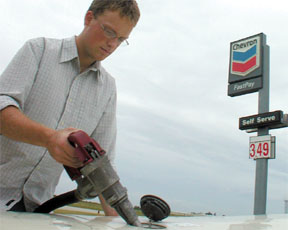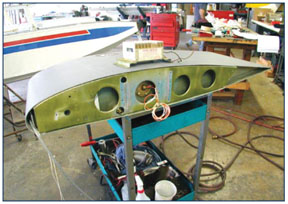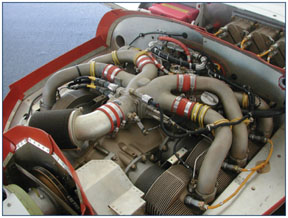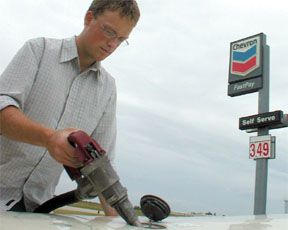
However unpleasant the specter of $4 avgas may be, it has become a harsh reality. The $5 barrier fell last spring and as we go to press, Signature at Teterboro, New Jersey, can claim the highest avgas price in the country: $6.10. In the U.S., fuel has never been the most expensive component of flying cost, but it could soon get that way and even if it doesnt, no other factor more threatens GA growth and usefulness than the rising cost of gas.
Although aircraft owners cant do much about the global price of crude oil, we can certainly do more to make our airplanes use less of it. Some of these measures require minor or major investments in the airframe, but the largest gains are to be had simply by flying the airplane more efficiently and learning to lean effectively. Were loathe to say it, but owners of some twins are coming to the unwelcome realization that a handful of modern single-engine airplanes are not only faster but cost less than half as much to operate as even a modest twin. The comfort of having a second engine is likely to grow increasingly expensive, so certain aspects of the used single-engine market may soon heat up.
Herewith, presented in order of cost effectiveness, are an even dozen ideas on how to either save gas directly or reduce fuel-related operating costs. Some require minor habit changes; others require modifications or upgrades to the aircraft.
IDEA 1: LEAN-OF-PEAK
This topic has been addressed ad nauseam during the past five years, including by us. We long ago grew weary of ill-founded arguments from mechanics and engine shops that lean-of-peak operation somehow causes burned valves or reduces engine life. We reject these claims and so should you.
As far as were concerned, the data that indicates that correctly executed lean-of-peak operation both saves fuel and lowers EGTs and CHTs is inarguable and people who claim otherwise don’t know what theyre talking about. We cant make it any plainer than this.
But there’s always a catch. Lean-of-peak operation isn’t a panacea. It doesnt work we’ll in all engines, it requires reduced cruising speed and you need good instrumentation and some basic knowledge to use it to best advantage. And sometimes, it doesnt make sense from an operational point of view. Lean-of-peak operation isn’t something for nothing; you’ll have to fly slower to realize efficiency but the gains are usually worth it.
Here are some numbers. Our turbocharged Mooney 231 burns about 13.5 GPH in the mid-teens to fly at a true airspeed of about 165 knots, leaned rich of peak. Operated lean of peak TIT, the airspeed drops 10 knots to about 155 knots or a little less, on a fuel flow of 9 GPH. The rich setting delivers about 12 NMPG, the lean setting about 17 NMPG, a 42 percent improvement in economy. Looked at another way, flying lean of peak EGTs/TITs is like having not quite half again as much fuel capacity without paying for it.
And fuel capacity-endurance, really-is of itself an economy enhancer.Heres why: Having additional endurance makes it more likely that you can complete a trip without a fuel stop. For turbocharged airplanes, fuel stops are efficiency killers because the long climb back to altitudes where the turbos speed is a plus require time and fuel. Even in a non-turbocharged airplane, fuel stops cost time and fuel; they never improve efficiency.Increased endurance through lean-of-peak operation translates to more loading and weather options, too. If you have more endurance, you can reach a wider range of alternates if the weather tanks or you can shortload fuel in favor or more cabin payload.
Lean-of-peak operation works we’ll in most Continental fuel-injected engines and somewhat less we’ll in Lycoming fuel-injected engines, but is still worth considering as an endurance extender.
Were told by George Braly of General Aviation Modifications, whose research has recently illuminated an understanding of lean-of-peak operation, that carbureted engines can also be operated lean of peak if partial carb heat is used to increase the induction temperature. This improves fuel atomization and distribution and reduces so-called dropouts, when fuel vapor condenses in the induction systems twists and turns. Although weve flown Continental and Lycoming injected engines lean of peak, we havent tried this method in a carbureted engine. Although were skeptical of its practicality, we think its worth experimenting with.
Whether injected or carbureted, an engine should have a digital multi-probe engine monitor with both EGT and CHT before lean of peak is attempted.At high power settings, its possible to damage valves and cylinders by hamfisting the mixture control. (This is why some engine shops think LOP damages engines and done incorrectly, it certainly has that potential.)
And there are circumstances where lean-of-peak operation makes little sense, usually when flying into a stiff headwind when the fuel economy tradeoff just isn’t worth the slow groundspeed. In this case, go rich of peak and pay for the gas. For more technical detail on lean-of-peak operation, see www.gami.com or search lean of peak on our online sister publication, www.avweb.com.
IDEA 2: GAMIJECTORS
Beginning in 1996, GAMI reinvigorated research into aircraft engine technology and among other ideas- including a focus on lean-of-peak operation-this yielded GAMIjectors. These are custom fuel-injector nozzles that precisely match the fuel going into the cylinder to the air available through the induction system.
GAMIjectors yield generally smoother operation and definitely more even leaning, making it possible to operate lean of peak without undue roughness.Not all fuel-in jected engines need or will necessarily benefit from GAMIjectors, but our surveys reveal that most have. GAMIjectors range in price from $699 to $999, depending on engine model. Contact www.gami.com for more. If GAMIjectors are required for lean-of-peak flight, at current gas prices, the payback may be in as little as 150 hours.
IDEA 3: AIRNAV.COM
In our view, this is one of the most underutilized services in general aviation. For several years, AirNav has been tracking avgas prices based on voluntarily submitted reports from the field. This service is we’ll executed and available for free to anyone who logs on at www.airnav.com. Although using it wont save gas, it will certainly save money on buying gas-a lot of money.
For example, if you were flying along the eastern seaboard recently and needed a fuel stop in South Carolina, you could pay Signature $4.35 a gallon in Savannah, taxi down to the self-serve pumps and pay $3.79 a gallon or route through Darlington and pay $3.05. On a fill-up of a modest single, the most/least difference is more than 40 percent and we’ll worth considering re-routing, in our view. Further, we think FBOs who are efficient and willing to accept lower margins deserve support. This also pressures higher-priced players to offer more competitive prices. AirNav has basic utilities that allow you to plan routing based on the lowest fuel prices.

IDEA 4: BIGGER TANKS
The hackneyed adage about never having too much fuel unless youre on fire definitely applies to economy considerations. One reason is the aforementioned extended endurance, which allows skipping a fuel stop. The second is buying cheaper fuel where you find it-or where AirNav finds it for you-and carrying it around with you.
While the airlines have learned that tankering fuel is an economy no-no, that proviso doesnt apply to small piston aircraft. Yes, you burn a little more gas to haul your stash of fuel, but not enough to offset even a 25-cent-per-gallon price Delta, and weve seen price breaks between the highest and lowest of over $2. Extended capacity tanks are available for a range of models, mostly mid- to high-performance singles. Adding even 15 gallons can make a difference if you fly trips to near the limits of the airplanes fuel endurance.
Prices on these systems vary between $4000 and $8000 and some include STCs for gross-weight increases. See Aviation Consumer March 2004 for a complete analysis. Extended range tanks are a moderately expensive upgrade but can pay big dividends.
IDEA 5: CHECK THE RIGGING
Its not unusual to see cruise speed differences between two airplanes of the identical type and model year. Tracking down the reason for cruise shortfalls is black art but rigging is often implicated; ailerons are out of trim, the rudder doesnt center-up, flaps arent completely retracting; gear doors don’t close.
Recovering 5 knots through rigging tune-up is hardly unusual and although the fuel efficiency gain is small one, its nonetheless measurable and not expensive. Some caution is advised, however. If a shop isn’t thoroughly familiar with your airplane or otherwise a whiz at rigging, you might make things worse. Rigging checks arent expensive.
IDEA 6: GENERAL MAINTENANCE
The big items here are spark plugs, harnesses and magnetos and inducation leaks, probably in that order. The onset of roughness during leaning is often caused by a fouled or defective plug, old harnesses or a magneto past its prime. If you cant lean effectively-you’ll probably be unable to run lean of peak-youre wasting gas. Another trouble-causer is leaking induction pipes; these too will cause roughness and an inability to run lean of peak, not to mention EGT and CHT spikes above normal. Last, check air and fuel filters.These are normally tended to at annual but may have been missed last time around. This is routine, inexpensive maintenance.
IDEA 7: OPTIMIZE ALTITUDE
This is a cheap fix if ever there was one. When you last looked at a winds aloft forecast, did you really look? If you didnt, you may have given up speed into a headwind or failed to take advantage of a blistering tailwind because you werent willing to climb a couple of thousand feet higher. Thats the same as wasting gas.
As a survival skill, some airlines are masters at altitude optimization and most flight planning programs will crunch what-if numbers to find the most favorable winds based on the airplanes typical flight profile.
Again, airplanes with the most altitude capability-read that as turbocharged-will benefit the most from altitude optimization. GPS, airdata and real time winds aloft help with optimization, as we discovered in reviewing the EFB software from TrueFlight, which we’ll report on in a future issue. This program works in real time to optimize altitude choices. (See www.aviationsafety.com for more.)
IDEA 8: DUMP THE GUZZLER
If you can afford a twin with a pair of large-displacement six-cylinder engines, you may not care about fuel economy. Then again, maybe you do, to the extent that you don’t fly as much because filling it up costs nearly a grand. Timing the market to buy or sell right is fraught with peril but in our estimation, prices on twins are likely to remain soft. Its difficult to foresee market forces that will reverse this trend.
On the other hand, if youre thinking about a more fuel-efficient airplane-any of the Mooney models, Diamonds DA-40 or even a used Cirrus SR-20-it might be better, so shop sooner rather than later.
IDEA 9: TURBOCHARGING
Turbocharging or turbonormalizing isn’t normally thought of as an economy measure but it can be, provided that the airplane is flown high enough to take advantage of the turbos altitude capabilities, the pilot is reasonably canny about altitude optimization and lean-of-peak operation is considered.
A gas-swilling turbocharged twin will never be an economy leader no matter how its flown. But a turbocharged Bonanza, Mooney or Cessna 210 can be.Switching from a normally aspirated airplane to a turbocharged airplane as an economy measure only makes sense if the owner flies long trips frequently and is otherwise thinking about an upgrade. Otherwise, turbochargings higher maintenance costs will more than offset any dollars in fuel savings. Still, if you lean correctly, you’ll use marginally less fuel on those trips where climbing ramps up the speed, especially in tailwinds. Buying a turbocharged airplane or adding it to one you already own is a dubious return on investment if you fly under 100 hours a year.
IDEA 10: BUY A DIESEL
The diesels are coming, alright. Although the numbers arent right yet, they soon will be. It makes no sense to sell your $150,000 gasoline-powered twin and buy a $450,000 Diamond TwinStar just to save gas. On the other hand, if youre shopping for a new airplane, it makes just as little sense not to at least look closely at the DA42 TwinStar. We predict Diamond will introduce it sooner rather than later to the U.S. market.

IDEA 11: FADEC
Full authority digital engine controls have gotten a lot of press but sales havent followed. We think the reason for this is that the only flying system-Continentals Aerosance-developed PowerLink-is complex and expensive and its benefits are currently elusive. Fuel savings of 10 percent are reported by owners, but currently, you can do better by leaning aggressively. FADECs benefit will arrive when 100LL avgas disappears. T hat hasnt happened, so FADEC goes near the bottom for cost effectiveness.
IDEA 12: SPEED MODS
Pulling up the rear in cost effectiveness are speed mods. Speed mods-at least those that deliver on their claims-increase speed by reducing drag or, looked at another way, they allow the same speed on less fuel. The usual rule of thumb is that it costs $1000 per knot of increased airspeed, which might translate to a tenth of a gallon or two of fuel savings.
In reality, speed gains from mods are sometimes elusive and thats also true of fuel economy based on drag reduction. Thats why we put speed mods at the end of the list. The return on investment may or may not be worth it, either in speed or economy. don’t expect miracles, although some airframes will benefit enough to make the investment worthwhile.
Also With This Article
“Lean of Peak, Yes. But How Lean?”


